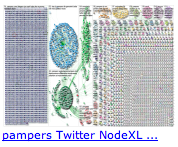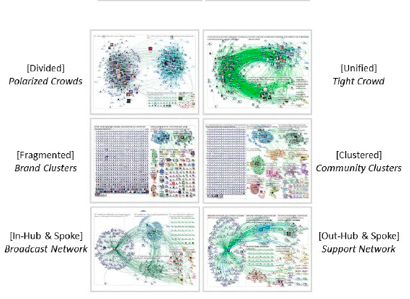Mapping Brand Networks in Social Media: Huggies vs. Pampers
At the upcoming Consumer Goods Sales & Marketing Summit, (#CGSM15) Dr. Marc Smith, director of the Social Media Research Foundation will speak about the ways social network analysis can be applied to better understand social media. He will demonstrate a free and open tool, NodeXL, that expands the function of the familiar Excel spreadsheet to provide an easy to use, powerful network analysis of social media. Here is a snapshot of what Smith will reveal during his highly-anticipated session:
The collection of connections created when people tweet about popular brands can be analyzed and visualized to create a kind of aerial photo of the crowd. Compare, for example, these two images of the crowds of people who recently tweeted the terms "Huggies" or "Pampers":


Each brand has attracted thousands of people and tweets, and they form similar patterns. A large group of people are "isolates" — they tweet about the brand but do not talk to others about it. Isolates are like islands, they do not say the names of other people and no one mentions their names. These people are an indication of the "brand" quality of a topic. Many subjects are not brands and they have few or no isolate users, in contrast.
At the center of these networks are large circular hub-and-spoke shapes, each with a brand account at the center. These are "broadcast" rings created when one account is retweeted by many others. Sometimes brand accounts create content that gets re-retweeted — creating a second or sometimes even a third ring around the brand.
In some areas of the network people form many connections with one another, not just sharing a single link to a common hub. These dense clusters of relationships are indicators of "community".
Some clusters are self-contained and have few links to other groups, while others are closely tied sub-regions of another group. Some rare users link across the divides between separate groups playing the role of "bridges".
People who occupy rare and strategic locations in these networks (like hubs and bridges) may be "influential". Engaging these users more than others may offer better returns on your social media investments.
Not all networks look like maps of big brands. Some topics are smaller and lack the presence of "isolates".
Recent research from Pew Research Internet Project in collaboration with the Social Media Research Foundation has documented that there are six basic forms of social media network: divided, unified, fragmented, clustered, and in and out hub-and-spoke:


Brands can benefit from identifying which pattern they currently most resemble as well as identifying the pattern that most matches their brand communication goals. Often a braodcaster wants to have more community, or a community wants to gain more visibility and "brand". Using network metrics and maps, it is possible to navigate between these network structures.
Networks are a powerful way of thinking about markets and consumer conversations. New tools are making network analysis as easy as making a pie chart. The result is an expansion of "network consciousness" as business decision makers are increasingly able to "think link" when they look at social media and market data.
Interested in seeing what your brand's social media network looks like? Request a free sample network map and report from http://connectedaction.net.
The collection of connections created when people tweet about popular brands can be analyzed and visualized to create a kind of aerial photo of the crowd. Compare, for example, these two images of the crowds of people who recently tweeted the terms "Huggies" or "Pampers":


Each brand has attracted thousands of people and tweets, and they form similar patterns. A large group of people are "isolates" — they tweet about the brand but do not talk to others about it. Isolates are like islands, they do not say the names of other people and no one mentions their names. These people are an indication of the "brand" quality of a topic. Many subjects are not brands and they have few or no isolate users, in contrast.
At the center of these networks are large circular hub-and-spoke shapes, each with a brand account at the center. These are "broadcast" rings created when one account is retweeted by many others. Sometimes brand accounts create content that gets re-retweeted — creating a second or sometimes even a third ring around the brand.
In some areas of the network people form many connections with one another, not just sharing a single link to a common hub. These dense clusters of relationships are indicators of "community".
Some clusters are self-contained and have few links to other groups, while others are closely tied sub-regions of another group. Some rare users link across the divides between separate groups playing the role of "bridges".
People who occupy rare and strategic locations in these networks (like hubs and bridges) may be "influential". Engaging these users more than others may offer better returns on your social media investments.
Not all networks look like maps of big brands. Some topics are smaller and lack the presence of "isolates".
Recent research from Pew Research Internet Project in collaboration with the Social Media Research Foundation has documented that there are six basic forms of social media network: divided, unified, fragmented, clustered, and in and out hub-and-spoke:


Brands can benefit from identifying which pattern they currently most resemble as well as identifying the pattern that most matches their brand communication goals. Often a braodcaster wants to have more community, or a community wants to gain more visibility and "brand". Using network metrics and maps, it is possible to navigate between these network structures.
Networks are a powerful way of thinking about markets and consumer conversations. New tools are making network analysis as easy as making a pie chart. The result is an expansion of "network consciousness" as business decision makers are increasingly able to "think link" when they look at social media and market data.
Interested in seeing what your brand's social media network looks like? Request a free sample network map and report from http://connectedaction.net.
